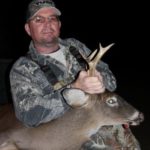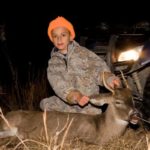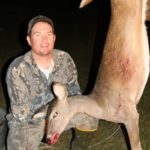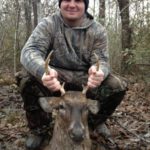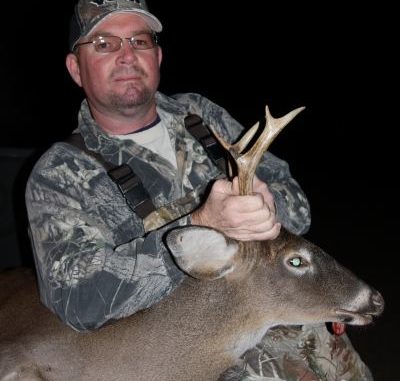
Are you a deer hunter or a deer manager? Taking a few steps toward managing your deer instead of just settling for what comes along can up the odds of success — and help turn you property into a deer home instead of a pass-through.
A tan streak flashed across the front of my truck as my son and I made our way to school a few weeks ago.
Bracing for the impact that never came, I just barely noticed the spotted fawn before it made the deadly decision to follow momma across the road.
The impact wasn’t anything more than running over an armadillo, and, although I was sure the fawn’s death was nearly instantaneous, it left a hole in my heart that I could not explain.
Unfazed by what had just unfolded before his eyes and seemingly irritated by my repeating, “Man, I can’t believe that,” over and over for the rest of our 14-mile trip, my son tried to get me to shut up by asking a question.
“What are you so upset about? Don’t we hunt to try to kill deer?” He asked.
“Yes, yes, we do,” I replied. “But things are different now.”
Different indeed. Not only was he starting junior high at a new school, but I had resigned my position at Boyet Junior High in the St. Tammany Parish school district to teach at Franklinton Junior High in Washington Parish just so I could be with him.
With a daughter still in second grade, I couldn’t help but feel that my son entering junior high school was the end of his beginning.
The dead fawn lying in the ditch was another end of a beginning.
Five years ago, former Louisiana Sportsman editor Todd Masson and I began a project at my small tract of land in Washington Parish that we hoped would provide a veritable deer oasis in the midst of properties managed by the if-it’s-brown-it’s-down philosophy.
Located on the banks of the Bogue Chitto River, this mixture of pine plantations and cutovers, hardwood stands, a jungle of fallen trees and impenetrable underbrush created by Hurricane Katrina, four home sites, three hay fields and a couple of sloughs provided an eclectic, if not all that impressive, canvas.
We made our inauspicious start by trying to scratch out a couple of openings on opposite sides of the property with a rusted out bush hog, a crooked blade, a disk that hadn’t been greased since my grandfather died in 1994, a couple of hand rakes and a 13-year-old nephew who provided our manual labor.
On an old logging deck that I had worked and reworked with the blade to even out a slope and fill in some ruts, we sowed oat seeds by hand, and covered them with the rake.
A couple of passes with the four-wheeler to press it all in, and we were done with what we named the cemetery stand because of the 100-year-old family cemetery situated on top of a bluff that overlooked this 700-square-foot “plot.”
I just about sealed the fate of the bush hog that was so very close to its end as we tried to scratch out a little area right on the edge of the Katrina jungle and a hardwood cutover.
A couple of sheered bolts and a bent bush-hog frame later, and we had carved out something that looked like the spokes of a bicycle wheel.
To tell the truth, I don’t remember if we called this one the spoke plot, the hub or what, but the name didn’t really matter because we were no longer deer hunters; we were deer managers.
The first couple of pictures we got on our trail cameras were of a skin-and-bones doe that had an even scrawnier looking fawn behind it.
They were actually eating some of the sparsely growing oats at the cemetery plot.
An immediate sign of success, we eagerly awaited the opening morning of rifle season.
Masson and I killed two deer that first year — one a knobby-headed spike that literally followed Masson and his son Joel in to the spoke stand and the other a skillet-headed doe off the cemetery stand.
We were so excited that you would have thought we had both taken Boone and Crockett bucks from the Midwest.
The next year, we focused on improving these two little plots while adding two more at another of my families properties about two miles down the road.
It started to seem to both of us that we got just as much, if not more, enjoyment out of planning and planting food plots than we did from the actual hunts.
I’ve been connected to my family’s land for all my life.
The little parcels are areas that no descendant would ever think about selling because our grandparents and great-grandparents would jump up out of their graves and haunt us the rest of our lives.
But this was different. Now, rather than just living on the land, I felt we were working to make the land better.
And, boy, did we start to see a difference.
After a little bulldozer work the third year, Masson and I started feeling as if we were hunting a high-fence property in Texas.
One or two deer every three or four hunts turned into 13 sightings in one hunt.
But the most telling sign was the increased size of the does that were now bearing twins rather than single fawns.
Even with all our efforts, our deer sightings remained does, fawns and the occasional spike or two.
Mature bucks remained our elusive goal.
We had an 8-point or two on our cameras in the pine plantation down the road, but they were always middle-of-the-night images of deer that were there one night and gone the next.
But they weren’t even showing up at night on our home cameras.
I kept thinking that, as long as we made this property attractive to does, bucks would eventually find it — and maybe one or two would find enough stuff to their liking to make them want to stick around.
Peanut butter, sliced apples, corn — we thought we had tried it all, but it wasn’t until we started planting summer food plots that we saw bucks starting to use the property.
After one summer of planting iron clay peas, we followed up the next summer with soybeans.
The deer hardly let them get past the two-leaf stage, and mowed down the three-quarter-acre soybean plot within days.
I pulled the camera card to see what was eating the soybeans, and saw some of the best-looking buck groups I had ever seen on my land.
Those deer never showed up during hunting season, but I killed a 2 ½-year old 6-point two years ago, while my nephew Zach put down another 2 ½-year-old 6-point the following season.
That’s when I realized we were nearing the end of the beginning.
In the span of five years, this property went from being one that deer passed through to one that deer called home.
Through our fervent effort to manage this small property, Masson’s son Joel killed his first deer. My son Matthew killed his first deer. My nephew Zach killed his first deer — a doe — and his first buck.
Sprinkle in my buck and two does, and a doe and yearling 3-point buck for Masson, and we saw exactly what a committed, albeit small, effort to improving deer habitat could do.
But it was those two successive 2½-year-old 6-points that really got me thinking.
I would have never told my nephew to not pull the trigger, and I was so surprised to actually see a buck that I couldn’t have passed even if I had wanted to.
Otherwise, what if we had let them walk?
Would they have returned the following year as 3 ½-year-old 8-points?
Who can say for sure?
“One thing’s for sure,” I told Zach as we loaded up his buck last season. “He’s as old as he’s going to get.”
It’s hard for me to believe that two more points on that deer would have made all that much of a difference in his eyes at the end of the blood trail.
However, deer hunters, even if they aren’t into horn porn, like to have a chance to see a big buck every now and then.
With one more first buck to kill for my son and a first deer and first buck for my daughter, last season marked the end of the beginning.
What Masson and I began five years ago has paid off in some fairly decent deer hunting, with more of an expectation of seeing a few deer than not.
We’ve just about maximized this property, so our management efforts will shift from planting more food plots to passing on more bucks — even if there’s no guarantee we’ll see them again the next season because of the proximity of Highways 16 and 60, and a gauntlet of surrounding hunters.
But there’s no way they’ll get bigger if we shoot them when they’re young.
That dead fawn on the side of the road made me realize that we aren’t managing pastures for cattle. These are wild animals that rely on instinct to survive.
The spotted fawn’s instinct was to follow momma — a decision that led to its death.
Our instinct might be to shoot any buck that comes out, but we have made the decision to pass on small bucks.
That second little spotted fawn I spotted in my review mirror after killing its sibling — maybe we get the chance to pass on it next year, if it is a buck.
I think I owe it that much.
